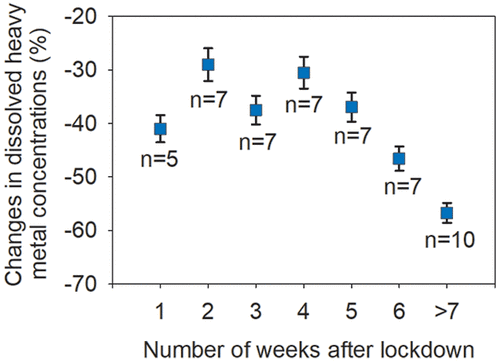当前位置:
X-MOL 学术
›
Environ. Sci. Technol. Lett.
›
论文详情
Our official English website, www.x-mol.net, welcomes your
feedback! (Note: you will need to create a separate account there.)
A Time-Series Record during COVID-19 Lockdown Shows the High Resilience of Dissolved Heavy Metals in the Ganga River
Environmental Science & Technology Letters ( IF 8.9 ) Pub Date : 2021-01-22 , DOI: 10.1021/acs.estlett.0c00982 Tanuj Shukla 1 , Indra S Sen 1 , Soumita Boral 1 , Sanjeet Sharma 1
Environmental Science & Technology Letters ( IF 8.9 ) Pub Date : 2021-01-22 , DOI: 10.1021/acs.estlett.0c00982 Tanuj Shukla 1 , Indra S Sen 1 , Soumita Boral 1 , Sanjeet Sharma 1
Affiliation

|
The world’s large rivers have been intensely studied to better understand the impact of climate change and direct human interventions on river water quality and quantity. Of particular importance is the extent to which industrial, domestic, and agricultural discharges are modifying the dissolved inorganic constituents (major elements, trace elements, nutrients, and heavy metals) of large river systems vis-à-vis water quality. The COVID-19 pandemic lockdown provides a rare opportunity to quantify the impact of restricted anthropogenic activities on the water chemistry resilience of large rivers. By analyzing the daily geochemical record of the Ganga River, we demonstrate that reduced industrial discharge during 51 days of mandated nationwide lockdown decreased the dissolved heavy metal concentrations by a minimum of 50%. In contrast, nitrate and phosphate inputs predominantly derived from agricultural runoff and domestic sewage maintained a chemical status quo as these sources were not impacted by the nationwide confinement or their residence time was longer than the characteristic time of the perturbation. We demonstrate the high resilience of dissolved heavy metals and conclude that industrial wastewater minimization programs will substantially improve heavy metal pollution of the Ganga River in a short time span of a few months.
中文翻译:

COVID-19 封锁期间的时间序列记录显示恒河中溶解重金属的高恢复能力
人们对世界上的主要河流进行了深入研究,以更好地了解气候变化的影响以及人类对河流水质和水量的直接干预。特别重要的是工业、家庭和农业排放在多大程度上改变了大型河流系统的溶解无机成分(主要元素、微量元素、营养物和重金属)相对于水质的程度。COVID-19 大流行封锁提供了一个难得的机会来量化受限制的人类活动对大河水化学恢复力的影响。通过分析恒河的每日地球化学记录,我们证明,在全国强制封锁的 51 天期间,工业排放的减少使溶解的重金属浓度至少降低了 50%。相比之下,主要来自农业径流和生活污水的硝酸盐和磷酸盐输入保持化学现状,因为这些来源没有受到全国封锁的影响,或者它们的停留时间长于扰动的特征时间。我们证明了溶解重金属的高恢复能力,并得出结论,工业废水最小化计划将在短短几个月的时间内大幅改善恒河的重金属污染。
更新日期:2021-01-22
中文翻译:

COVID-19 封锁期间的时间序列记录显示恒河中溶解重金属的高恢复能力
人们对世界上的主要河流进行了深入研究,以更好地了解气候变化的影响以及人类对河流水质和水量的直接干预。特别重要的是工业、家庭和农业排放在多大程度上改变了大型河流系统的溶解无机成分(主要元素、微量元素、营养物和重金属)相对于水质的程度。COVID-19 大流行封锁提供了一个难得的机会来量化受限制的人类活动对大河水化学恢复力的影响。通过分析恒河的每日地球化学记录,我们证明,在全国强制封锁的 51 天期间,工业排放的减少使溶解的重金属浓度至少降低了 50%。相比之下,主要来自农业径流和生活污水的硝酸盐和磷酸盐输入保持化学现状,因为这些来源没有受到全国封锁的影响,或者它们的停留时间长于扰动的特征时间。我们证明了溶解重金属的高恢复能力,并得出结论,工业废水最小化计划将在短短几个月的时间内大幅改善恒河的重金属污染。











































 京公网安备 11010802027423号
京公网安备 11010802027423号